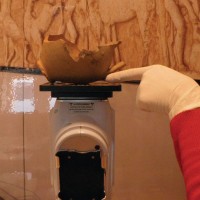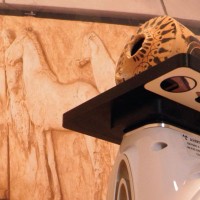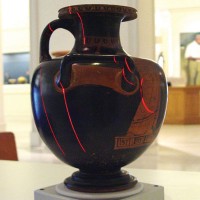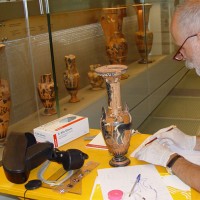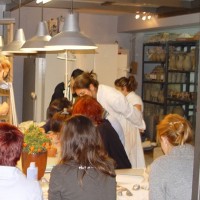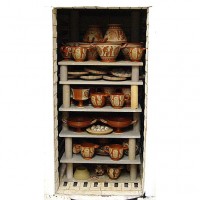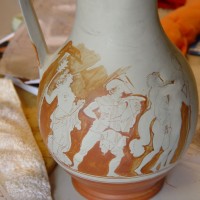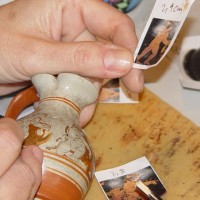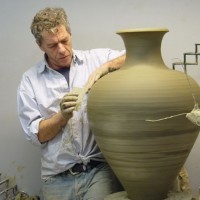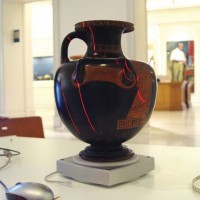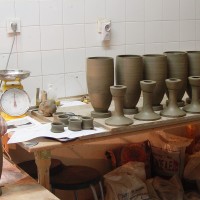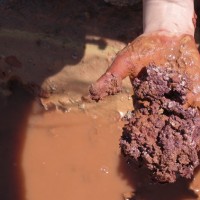TECHNICAL DESCRIPTION
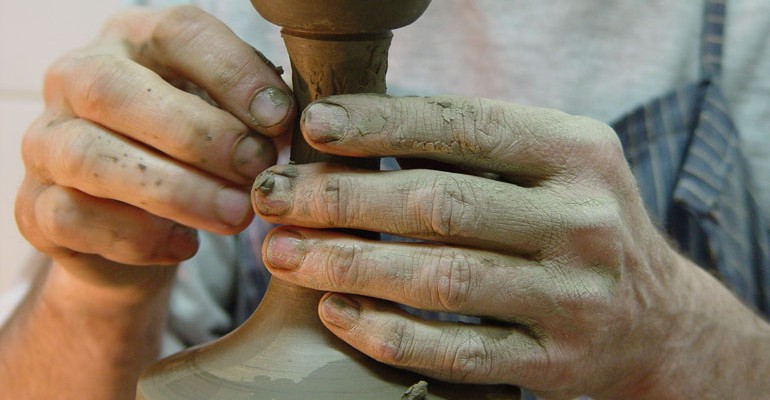
The two services to be designed and developed during the project have an intrinsic interdisciplinary character by combining:
a) high tech analytical methodology (i.e. scanning microbeam analysis, m-PIXE, topography and 2D tomography) with low tech skills and traditional craftsmanship,
b) recently acquired archaeological data with scientific results to be produced in the course of theproject,
c) digital and computer animated educational applications with actual hands-on educationalmaterial (i.e. in the form of a collection of ceramic reproductions) to be included in an Archaeological museum, as a means to interpret the extant antiquities exhibition,
d) experimentation with well established contemporary decoration techniques from high temperature ceramic industry (i.e. porcelain industry) that will be modified for the application on low temperature terracotta bodies requiring a complex firing cycle. Finally, since the Attic BG is a highly resistant alumino-silicate glass coloured by magnetite submicron particles, an attempt will be made during the project to further explore other uses of this high tech and environmentally friendly ancient nano-material. More specifically the project will be based on the following technical features:
1. Archaeological background, pottery styles, the masters: Though figural pottery in Greece begins in the Bronze Age, painted pottery reached its perfection through black-figured pottery in Corinth and Athens, the most important production centres in the early sixth century, with the Corinthian shapes, figures, and technical features, especially the use of incision, influencing Athens. Corinthian pottery declined in popularity and by around 550 B.C. Attic pottery had become dominant, remaining so until the fourth century. The glory years for Attic black figure are from about 560-520 B. C. when superb vases were created and exported to all parts of the Greek world, especially to Etruria (Exekias and the Amasis Painter). The invention of the red-figure style initiated great changes in the expressive possibilities of vase painting especially through younger artists who preferred to explore the possibilities of this new technique. The Andokides Painter is the earliest red-figure painter; particularly important are Euphronios and Euthymides who explored with brilliant success the possibilities of the new technique. Their use of dilute glaze and relief line resulted in subtlety of drawing impossible in black-figure which relied on incision as well as judicious use of accessory red (intentional red) and white for expressive purposes. The achievements of these pioneers were continued by the Kleophrades Painter and his colleague the Berlin Painter who specialized in pots. Their important colleagues are Onesimos, the Brygos Painter, Makron and Douris, who preferred to decorate drinking cups. These artists brought new dimensions to the art of vase painting. Subjects from myth continued, but many painters depicted scenes from daily life, a focus that continued until vase painting ceased in the third quarter of the fourth century. During the middle years of the fifth century elegant white-ground funerary lekythoi were a prominent shape. Construction of the Parthenon was a high point for Athens; many vases of the late fifth century reflect the style of its sculpture and some of its subjects, such as the Gigantomachy krater in Naples, the work of the Pronomos Painter. The end of the Peloponnesian War was another watershed. In the fourth century Athenian pottery diminished in prominence, which is not surprising since Athens was no longer a political and cultural center. Good vases continued to be made and exported, especially to powerful northern Greece, while major centers of production for Greek vases during the fourth century are the colonies of Italy, in particular Apulia, Campania and Lucania, also Sicily.
2. Technological features of Attic pottery: Most of the materials and techniques of Attic vase painting have been studied in detail during the 20th century, especially the so-called iron reduction technique for the production of the black glaze (Jones 1986); the paint used for decoration prior to firing was based on the use of a colloidal fraction of an illitic clay rich in iron oxides and the colour was produced with a three stage firing under oxidizing-reducing-oxidizing conditions. Though the process has been fully understood and replicated (Aloupi 2008) there are technical issues to be solved especially with respect to special techniques and colours that attract the interest of scholars and art historians (Cohen 2006). The advent of new non-destuctive microanalytical techniquesgives the possibility for the first time to analyze a set of well documented sherds from recent excavations from the centre of Athens conducted in view of the construction of the Athens METRO and the New Acropolis Museum. The differential microanalysis of specific decorative elements on the background (relief lines, added colours, polychrome decoration on top of white etc) will shed light on the possible use of organic additives such us honey, dregs of wine, oil etc which are expected to influence the trace elements composition such as Zn or Cu with simultaneous increas eof Na or K. The analysis of the ancient sherds will be compared with modern reproductions from the workshop ofTHETIS authentics Ltd in order to test several hypotheses for the tricks of ancient vase-painters suggested by scholars in the past.
3. Analysis of archaeological artefacts. Materials nad Methods:
The experimental work will be based on the surface analysis of carefully chosen decorated ceramic sherds from recent excavations on the slopes of the Acropolis and in the Kerameikos area, an ancient neighbourhood and the potters’ quarter in Classical antiquity. The sherds to be analysed represent different styles,
a) they are decorated with very fine lines of black glaze (red figure style) of the order of 0,2-1mm that stands out of the substrate, i.e. the so-called relief line with occasional presence of added colours (white and coral red),
b) they bear very fine polychrome lines on a white kaolinite slip (white lekythoi),
c) a collection of sherds from a unique find, in the slopes of the Acropolis related to the well-known potter and vase-painter Exekias (referred to above) who is considered as the one introducing innovations and new styles in Athenian pottery,
d) a number of plain black sherds from the Acropolis spanning the period from 8th to 3rd century BC with a view to examine the evolution of the BG technique with time and possibly detect the use of different clay sources in Attica and the neighboring islands for the black glaze “paint” preparation.
e) The sherds bearing the relief decoration line will be supplied by the Greek Archaeological Service especially for the project.
The microbeam analytical techniques will give reliable information for different kind of materials under question i.e. trace elements composition of the relief lines compared to the black glaze background, comparison of coral red and black glaze composition, topographic information for the white kaolinitic slip especially with respect to the formation of gypsum. The project will also make use of data obtained in the past by using SEM-EDX technique, XRF, surface XRD and near-IR on similar pottery sherds. This stage of the project forms part of a wider research program on special techniques of the Attic Pottery directed by THETIS authentics Ltd in collaboration with research groups from “DEMOKRITOS”, BerlinTechnical University and Barcelona University.
4. 3D laser technology in heritage sector: Many conservation laboratories in Europe and other cultural entities from the private sector providehigh resolution 3D laser scanning services to the heritage sector, including 3D laser scanning, contact free replication of artifacts, post-processing of 3D data, 3D CAD design, 3D virtual reconstruction. Scanning can be carried out either in the secure environment of a conservation laboratory of a Museum or on-site in almost any location if the object cannot be moved. All 3D data collected during the recording of an artwork can result to valuable information and side-products to be used by the art historian, the conservator, the museologist, the museum manager and finally the shop. Though in Greece 3D-laser scanning has been repeatedly applied to record museum objects, starting in 2004-2005, to our knowledge the data have not been fully exploited since in most cases the parties involved were mostly interested in demonstrating the applicability of the “new” technique/technology rather than incorporating the new approach to every-day practice. In our case 3D recording will be used as a dynamic tool in the first step of the reproduction procedure of a ceramic artifact, being in practice a natural development of the methodology applied so far by the personnel of THETIS authentics Ltd (i.e. documentation includes detailed digital photography, video recording, detailed measurements, creation of technical datasheets).
5. Production of decal prints using clay-based paints produced from colloidal suspensions. Since the invention of decals for decorating ceramics in 1750 when it was a highly technical process that only the initiated few could render (i.e for Wedgwood the use of decals for the production of “hand-decorated” tiles was kept a closely guarded secret). In the the 1960’s, printing technology has advanced at an amazing rate. Computerized scanners and image editors, desktop publishing and the internet, and an ever improving silk screen industry, have combined to make ceramic decals easy to use and in much variety. Modern decals for ceramics are based on fine-powder submicron inorganic pigments. It is expected that the clay colloid produced by THETIS authentics Ltd for the hand-decoration of ceramics, could be used for the production of monochrome decals with new clay-based “inks”. These modified decals will be particularly applicable to the production of high quality ancient ceramic copies since they’ll also be based on the 3D documentation data (unfolded to 2D), making the term “copy” suitable to describe the final ceramic product for the first time.
6. Multimedia educational material, personalized interactive material and hands- on actual ceramic reproductions: Simple, flexible, low-cost approaches that combine digital information and artistic inspiration with real-life experience offer very powerful tools for communicating scientific information to the 21st cent public. Soon after its creation, THETIS authentics Ltd organized a series of educational programs addressed to primary and secondary schoolchildren, archaeology students and the wider public in collaboration with the archaeological service or educational organizations (i.e.the Universities of Athens, Thessaly, Peloponnesus etc). Most of these very successful programs that combine theory with hands- on experience were realized with the contribution of specialists/experts (museologists, authors, schoolteachers, actors). THETIS has also collaborated with NGOs dealing with disabled and/or visually impaired people. The participating staff of “DEMOKRITOS” has a very long experience and special interest in communicating science to the public, while TOOL Ltd will satisfy the technical requirements for the multimedia productions at reasonable cost.

